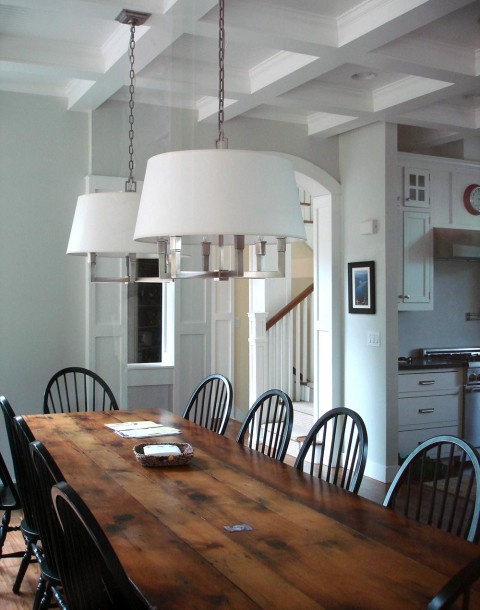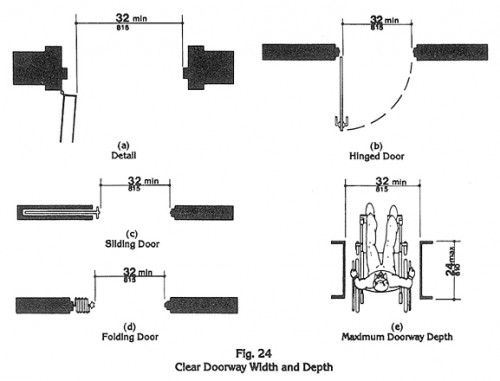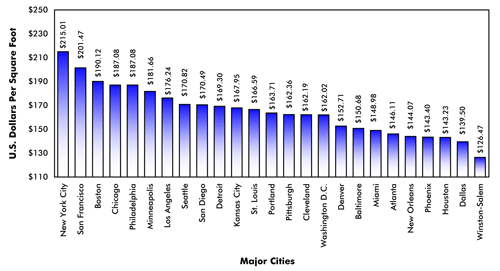Many common solutions we typically see in kitchens and baths are far from the best solutions, but are repeated again and again because people are not sure how to light those spaces well. Lighting design can transform a space from drab to dynamite. It’s especially important in kitchens and baths where we need the right light in the right place to perform tasks like chopping vegetables, shaving, and applying makeup.
Oops! #1: Putting recessed downlights (can lights) everywhere. This is one of the most common errors that lighting design professionals see. Can lights can be very inexpensive, and people often assume that laying them out in a regular grid gets light everywhere. Unfortunately, this is not so. The optics of inexpensive can lights often allow only slightly more than half the light of the lamp (bulb) to escape. What a waste! In addition, can lights, unless they are adjustable or wall wash fixtures, typically don’t put sufficient light on vertical surfaces, which is where the eye perceives light. With an array of cans, we might waste nearly half our watts and still have a space that feels like a cave. Also see Oops! #7.
Oops! #2: Forgetting task lights in the kitchen. The idea of adding a row of can lights over the counter falls under the category of Oops! #1. There are many better ways to light the counter, and one of them is to use fluorescent (T5), xenon or LED task lights under the upper cabinets. We do not recommend halogen because of its heat output. If your kitchen lacks upper cabinets where you’re doing work, despair not! This is a situation where wall-mounted or ceiling recessed adjustable fixtures with the right lamp (bulb) make all the difference. Adding several low voltage halogen fixtures with a narrow flood beam distribution and focusing them on the task area will also work well. Remember to choose your fluorescent or LED color temperature wisely.
Oops! #3: Using downlights over the vanity without adding lights on the side. Remember the grade school trick of holding a flashlight under your face and seeing the shadows magnify your visage into a gruesome caricature? The same is true in reverse. Standing directly under a downlight, without any light at the sides of the face, creates exaggerated and unflattering shadows. In the bathroom, using a downlight over the sink is fine to accent the expensive polished nickel faucet you’ve chosen, but it’s insufficient for tasks like shaving, tweezing, and applying makeup. For this, we need light at the sides of the mirror at eye level to minimize shadows and provide even distribution. This can be achieved with sconces flanking the mirror.
Oops! #4: Using incandescent or halogen bulbs without dimming. While we are all finding ways to retrofit lighting with more efficient, longer lived light sources than incandescent, it is still a viable and very important part of lighting in a residence, as long as it is dimmed. By dimming, we decrease energy and heat output, and we elongate lamp life. It’s important to train yourself and your family to dim incandescent sources as low as you can tolerate them. For more in depth information on this topic, read here.

Oops! #6: Neglecting to control different types of light separately. As mentioned in Oops! #5, it’s important to combine different types of light in each space. For maximum efficiency and flexibility, each type of light should be controlled separately, and any incandescent or halogen light, or dimmable LED’s (check with the manufacturer for specific requirements) should be dimmed. Controlling multiple sources can be achieved by the old school method of multiple light switches, but there are many more sophisticated ways to achieve control. From a simple programmable wallbox system for single room control with preset scenes, to wireless controls that generate their own power and can be reprogrammed from your laptop or phone, controlling the lighting means you save energy while getting the light you need.
Oops! #7: Putting recessed downlights in a high ceiling for ambient light. A corollary to Oops! #1, this tactic results in a lot of wasted light and a very dark space. Light originating at high ceilings needs to have a very focused, tight beam spread, or be reflected off the ceiling. With a high ceiling, reflecting light off a light, matte ceiling surface often provides much better illumination than punching a lot of holes for recessed downlights.
Oops! #8: Choosing dark colors everywhere without adjusting the lighting. While dark, saturated colors can provide a very enticing interior setting, they absorb light, requiring more energy for the space to have the same illuminance level as one with paler colors. Many LEED-certified buildings, such as the U.S. Green Building Council’s new headquarters, use white or pale colors as a way to reflect as much light as possible. This can create a significant energy savings since both daylight and artificial light are reflected deep into the space. Where possible, limit use of dark colors to spaces where task lighting or high lighting levels are less critical, like powder rooms that aren’t used as full baths, formal dining rooms that do not double as work spaces, or on accent walls or trim. If you must use dark colors in spaces where higher light levels are needed, add additional light sources and use higher wattage lamps.
Oops! #9: Decorating with light. Lighting designers think about light as an actual dimension, imagining the distribution and output from each fixture, as well as the quality of the light and color. Decorating with light fixtures, or choosing fixtures based on how they look rather than their light output, performance, and distribution often results in a waste of energy and less than optimal light output. For assistance with architectural (and yes, decorative) light fixture choices, consider hiring a professional lighting designer who can transform your space through light, while providing adequate task lighting and often saving energy.








